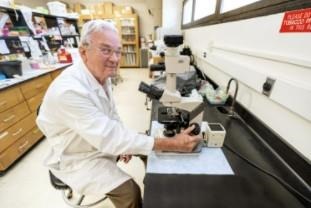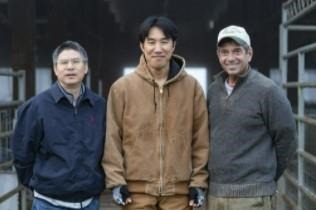The team, with Fuller Bazer, Ph.D., Regents Fellow, Distinguished University Professor, Presidential Impact Fellow and holder of the O.D. Butler Chair in Animal Science, as lead, was recently granted a U.S. Department of Agriculture National Institute of Food and Agriculture grant for $650,000.
This new grant builds on nearly 30 years of research the team has conducted, Bazer said. This project, “Arginine and Creatine Kinase: Key Roles in Conceptus Development,” specifically aims to combine the areas of nutrition and reproduction to develop strategies to increase reproductive success in livestock enterprises.
The team consists of Bazer and Guoyao Wu, Ph.D., distinguished professor and Texas A&M AgriLife Research Senior Faculty Fellow, both in the Texas A&M Department of Animal Science, College of Agriculture and Life Sciences. Joining them are Greg Johnson, Ph.D., professor, and Heewon Seo, Ph.D., research assistant professor, both in the Veterinary Integrative Biosciences, College of Veterinary Medicine and Biomedical Sciences.

Fuller Bazer, Ph.D., holder of the O.D. Butler Chair in Animal Science, leads a team of researchers using dietary supplements to female pigs to improve the overall litter weight and health of individual babies. (Texas A&M AgriLife photo by Laura McKenzie)
“We believe by supplementing diets with specific amino acids, such as arginine, and creatine — a very doable practical approach for producers — we can deliver those nutrients that we know are very critical for growth and development of the embryo and fetus during the course of gestation,” Bazer said. “This is going to give the producer more offspring and healthier offspring, and of course, that’s really the bottom line in terms of taking them to market — that’s the profitability margin that farmers and ranchers are looking for.”
Key roles for arginine in development
While arginine was traditionally considered a nonessential amino acid because it is produced in the body, Wu said the team’s work has shown that the amount of arginine produced in a pig’s body is insufficient under certain physiological conditions, such as pregnancy, and thus it is a “conditionally essential amino acid.”
“The work we do is basic research — nutrition and reproduction interaction,” Bazer said. “Arginine enhances embryonic and fetal growth and survival.”

Additional team members are, left to right, Guoyao Wu, Ph.D., distinguished professor and Texas A&M AgriLife Research Senior Faculty Fellow; and Heewon Seo, Ph.D., research assistant professor, and Greg Johnson, Ph.D., professor, both in the College of Veterinary Medicine and Biomedical Sciences. (Texas A&M AgriLife photo by Laura McKenzie)
Arginine plays a key role in pregnancy. First, arginine gets converted in the body to nitric oxide, which, similar to nitroglycerin in humans with heart problems, stimulates blood vessel growth and promotes dilation of the blood vessels. This allows more blood with its key nutrients to be delivered to the uterus, which supports fetal-placental growth and development throughout pregnancy.
“So, you get a better blood flow to the reproductive tract,” Bazer said.
Arginine also gets converted to another set of compounds, called polyamines, which are involved in many cellular functions critical for gene expression as well as DNA and protein synthesis. Methionine is required for converting arginine into polyamines in pigs.
Furthermore, arginine gives rise to creatine, which Bazer and his partners believe can help overcome the birth of runt piglets and improve neurological functions in piglets. Creatine also promotes skeletal muscle development, so the offspring are expected to be physically stronger and bigger.
Zeroing in on the effects of creatine
Bazer said their research is determining whether creatine influences the amount and type of skeletal muscle in pigs. Another question is whether supplementing sows’ feed increases the weight and muscle mass of piglets, which is important for their survival and meat and meat products that they will yield.
“We think the creatine can help overcome the birth of runt piglets,” he said. “If producers can save them, that’s worth a lot of money. It takes about seven piglets to break even – if you can save two or three runt piglets per litter, they are worth about $50 per piglet.”
While increasing the amount of muscle is the primary function, the creatine supplementation will also help with the piglets’ neurological function. This would help overcome or prevent the adverse effects of low oxygen during and immediately after birth.
“As much as 10% of piglets are killed when the mother lies down on them because the piglets are not alert enough to get out of the way,” he said.
Making a difference
By supplementing the diet with arginine, something producers can do by just changing their feed formulation, “we believe they will see a difference in the reproductive outcomes,” Bazer said.
The end goal is to take this basic research to the marketplace by developing supplements for diets — a very doable and practical approach, he said.
In the marketplace, he said, the research has much greater implications. Once this information is worked out with domestic animals — particularly pigs but also cattle, sheep and goats — the information could be used for biomedical and medical sciences.
“We know small-for-date babies exist in human pregnancies, especially where you have adolescent girls getting pregnant,” he said. “But, in general, there’s always an interest in trying to make sure babies grow at the proper rate so they’re not small and have to go in an incubator to survive.”
Source : tamu.edu